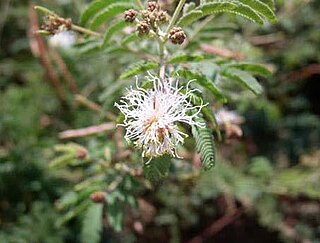
Ayahuasca is a South American psychoactive brew, traditionally used by Indigenous cultures and folk healers in Amazon and Orinoco basins for spiritual ceremonies, divination, and healing a variety of psychosomatic complaints. Originally restricted to areas of Peru, Brazil, Colombia and Ecuador, in the middle of 20th century it becomes widespread in Brazil in context of appearance of syncretic religions that uses ayahuasca as a sacrament, like Santo Daime, União do Vegetal and Barquinha, which blend elements of Amazonian Shamanism, Christianity, Kardecist Spiritism, and African-Brazilian religions such as Umbanda, Candomblé and Tambor de Mina, later expanding to several countries across all continents, notably the United States and Western Europe, and, more incipiently, in Eastern Europe, South Africa, Australia, and Japan.

N,N-Dimethyltryptamine is a substituted tryptamine that occurs in many plants and animals, including humans, and which is both a derivative and a structural analog of tryptamine. DMT is used as a psychedelic drug and prepared by various cultures for ritual purposes as an entheogen.

5-MeO-DMT (5-methoxy-N,N-dimethyltryptamine) or O-methyl-bufotenin is a psychedelic of the tryptamine class. It is found in a wide variety of plant species, and also is secreted by the glands of at least one toad species, the Colorado River toad. Like its close relatives DMT and bufotenin (5-HO-DMT), it has been used as an entheogen in South America. Slang terms include Five-methoxy, the power, bufo, and toad venom.

Phalaris arundinacea, or reed canary grass, is a tall, perennial bunchgrass that commonly forms extensive single-species stands along the margins of lakes and streams and in wet open areas, with a wide distribution in Europe, Asia, northern Africa and North America. Other common names for the plant include gardener's-garters and ribbon grass in English, alpiste roseau in French, Rohrglanzgras in German, kusa-yoshi in Japanese, caniço-malhado in Portuguese, and hierba cinta and pasto cinto in Spanish.

Several alkaloids that function as monoamine oxidase inhibitors (MAOIs) are found in the seeds of Peganum harmala, as well as tobacco leaves including harmine, harmaline, and harmalol, which are members of a group of substances with a similar chemical structure collectively known as harmala alkaloids. These alkaloids are of interest for their use in Amazonian shamanism, where they are derived from other plants. The harmala alkaloid harmine, once known as telepathine and banisterine, is a naturally occurring beta-carboline alkaloid that is structurally related to harmaline, and also found in the vine Banisteriopsis caapi. Tetrahydroharmine is also found in B. caapi and P. harmala. Dr. Alexander Shulgin has suggested that harmine may be a breakdown product of harmaline. Harmine and harmaline are both a reversible inhibitor of monoamine oxidase A (RIMAs). They can stimulate the central nervous system by inhibiting the metabolism of monoamine compounds such as serotonin and norepinephrine.

Phalaris is a genus of grasses. Various species of Phalaris grow on every continent except Antarctica. They can be found in a broad range of habitats from below sea level to thousands of feet above sea level and from wet marshy areas to dry places. P. arundinacea and P. aquatica are sometimes invasive species in wetlands.

Psychotria viridis, also known as chacruna, chacrona, or chaqruy in the Quechua languages, is a perennial, shrubby flowering plant in the coffee family Rubiaceae. It is a close relative of Psychotria carthagenensis of Ecuador. It is commonly used as an ingredient of ayahuasca, a decoction with a long history of its entheogenic use and its status as a "plant teacher" among the Indigenous peoples of the Amazon rainforest.
Harmine is a beta-carboline and a harmala alkaloid. It occurs in a number of different plants, most notably the Syrian rue and Banisteriopsis caapi. Harmine reversibly inhibits monoamine oxidase A (MAO-A), an enzyme which breaks down monoamines, making it a Reversible inhibitor of monoamine oxidase A (RIMA). Harmine does not inhibit MAO-B. Harmine is also known as banisterin, banisterine, telopathin, telepathine, leucoharmine and yagin, yageine.

Harmaline is a fluorescent indole alkaloid from the group of harmala alkaloids and beta-carbolines. It is the partly hydrogenated form of harmine.
Pharmahuasca is a pharmaceutical version of the entheogenic brew ayahuasca. Traditional ayahuasca is made by brewing the MAOI-containing Banisteriopsis caapi vine with a DMT-containing plant, such as Psychotria viridis. Pharmahuasca refers to a similar combination that uses a pharmaceutical MAOI instead of a plant.

Diplopterys cabrerana is a shrub native to the Amazon Basin, spanning the countries of Brazil, Colombia, Ecuador and Peru. In the Quechua languages it is called chaliponga or chagropanga; in parts of Ecuador it is known as chacruna—a name otherwise reserved for Psychotria viridis.

Desmanthus is a genus of flowering plants in the mimosoid clade of the subfamily Caesalpinioideae of the pea family, Fabaceae. The name is derived from the Greek words δεσμός (desmos), meaning "bundle", and ἄνθος (anthos), meaning "flower". It contains about 24 species of herbs and shrubs that are sometimes described as being suffruiticose and have bipinnate leaves. Desmanthus is closely related to Leucaena and in appearance is similar to Neptunia. Like Mimosa and Neptunia, Desmanthus species fold their leaves in the evening. They are native to Mexico and North, Central and South America. Members of the genus are commonly known as bundleflowers. Donkey beans is another common name and originated in Central America, where Desmanthus species are highly regarded as fodder for these domestic draught animals.

N-Methyltryptamine (NMT) is a member of the substituted tryptamine chemical class and a natural product which is biosynthesized in the human body from tryptamine by certain N-methyltransferase enzymes, such as indolethylamine N-methyltransferase. It is a common component in human urine. NMT is an alkaloid derived from L-tryptophan that has been found in the bark, shoots and leaves of several plant genera, including Virola, Acacia, Mimosa, and Desmanthus—often together with the related compounds N,N-dimethyltryptamine (DMT) and 5-methoxy-N,N-dimethyltryptamine (5-MeO-DMT).

Indole alkaloids are a class of alkaloids containing a structural moiety of indole; many indole alkaloids also include isoprene groups and are thus called terpene indole or secologanin tryptamine alkaloids. Containing more than 4100 known different compounds, it is one of the largest classes of alkaloids. Many of them possess significant physiological activity and some of them are used in medicine. The amino acid tryptophan is the biochemical precursor of indole alkaloids.

O-Acetylpsilocin is a semi-synthetic psychoactive drug that has been suggested by David Nichols to be a potentially useful alternative to psilocybin for pharmacological studies, as they are both believed to be prodrugs of psilocin. However, some users report that O-acetylpsilocin's subjective effects differ from those of psilocybin and psilocin. Additionally, some users prefer 4-AcO-DMT to natural psilocybin mushrooms due to feeling fewer adverse side effects such as nausea and heavy body load, which are more frequently reported in experiences involving natural mushrooms. It is the acetylated form of the psilocybin mushroom alkaloid psilocin and is a lower homolog of 4-AcO-MET, 4-AcO-DET, 4-AcO-MiPT and 4-AcO-DiPT.

Zygophyllum fabago is a species of plant known by the common name Syrian bean-caper. It is considered a noxious weed of economic importance in much of the western United States. It is native to Asia and East Europe and Southeast Europe (Romania).

Desmanthus illinoensis, commonly known as Illinois bundleflower, prairie-mimosa or prickleweed, is a common plant in many areas of the south central and Midwestern US.

Desmanthus velutinus is a species of flowering plant in the legume family known by the common name velvet bundleflower. It is native to New Mexico and Texas in the United States and Coahuila in Mexico. It may also occur in Oklahoma.

Desmanthus virgatus is a species of flowering plant in the legume family that is known by many common names, including wild tantan, prostrate bundleflower, dwarf koa, desmanto, acacia courant, acacia savane, pompon blank, adormidera, brusca prieta, frijolillo, ground tamarind, guajillo, guashillo, huarangillo, langalet, petit acacia, petit cassie, petit mimosa, virgate mimosa, and slender mimosa, as well as simply desmanthus. It is native to the American tropics and subtropics but is present elsewhere as an introduced species. In some areas it is cultivated as a fodder and forage crop.

















